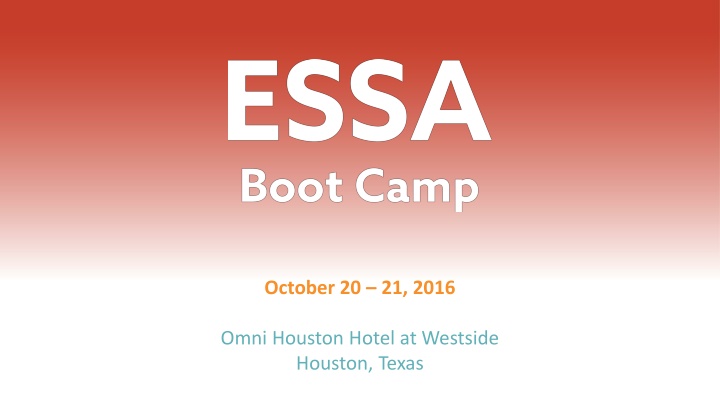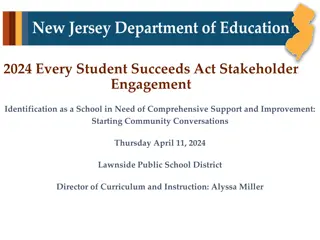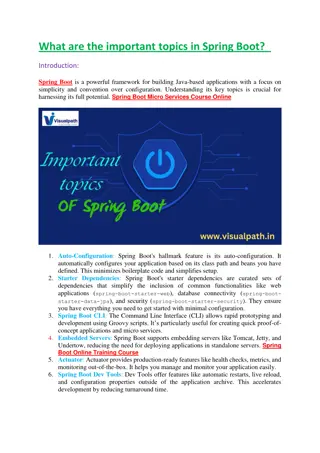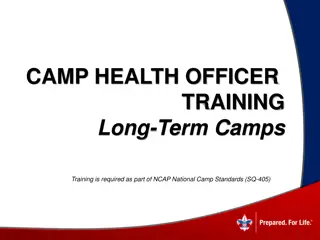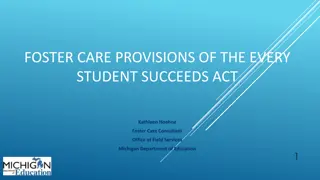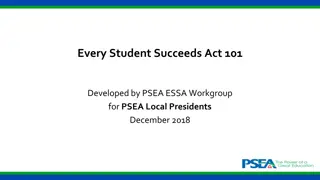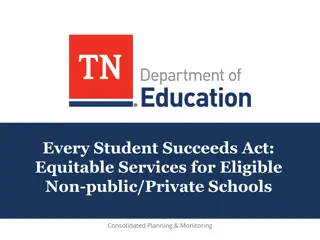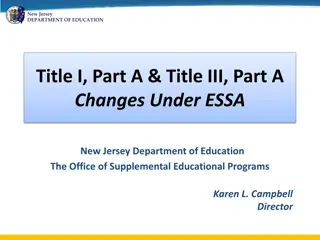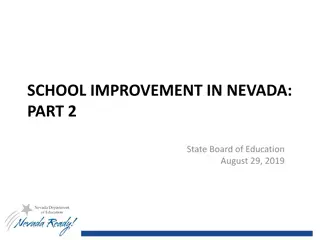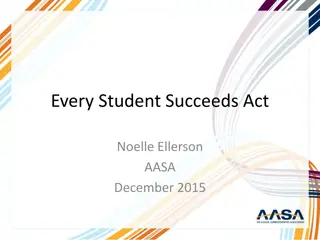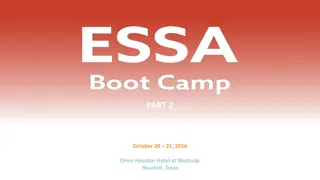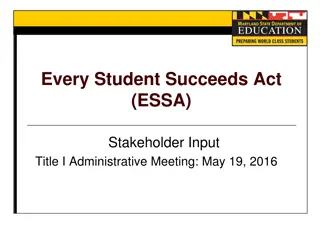ESSA Boot Camp - Understanding the Every Student Succeeds Act
The Every Student Succeeds Act (ESSA) has a rich history, replacing No Child Left Behind (NCLB) and its waivers. The law, signed in December 2015, marks a significant shift in federal education policy, emphasizing equity and outcomes over prescriptive inputs. Explore the key equity levers and goals of ESSA, including its impact on disadvantaged students through programs like Title I. Delve into the evolution from ESEA to ESSA, understanding the changes in requirements and expectations over time. Gain insights into the context and implications of ESSA, shaping a better understanding of federal education laws.
Download Presentation

Please find below an Image/Link to download the presentation.
The content on the website is provided AS IS for your information and personal use only. It may not be sold, licensed, or shared on other websites without obtaining consent from the author.If you encounter any issues during the download, it is possible that the publisher has removed the file from their server.
You are allowed to download the files provided on this website for personal or commercial use, subject to the condition that they are used lawfully. All files are the property of their respective owners.
The content on the website is provided AS IS for your information and personal use only. It may not be sold, licensed, or shared on other websites without obtaining consent from the author.
E N D
Presentation Transcript
SUBTITLE October 20 21, 2016 Omni Houston Hotel at Westside Houston, Texas ESSA Boot Camp | October 2016
ESSA 101 Optional Session ESSA Boot Camp | October 2016
Goals for Our Time Together Build shared knowledge about what s in the new federal education law the Every Student Succeeds Act (ESSA) Identify key equity levers in the law ESSA Boot Camp | October 2016
ESEA: Some history ESSA Boot Camp | October 2016
History: The Elementary and Secondary Education Act Originally passed in 1965, ESEA is the biggest federal K12 education law in the U.S. ESEA set up the Title I program, which currently provides more than $14 billion dollars to states to support the education of disadvantaged students. There have been many iterations of ESEA since the 1960s, and the law has changed a lot over time Initially lots of requirements related to inputs (how money could be used, etc.) Starting in 1994 More flexibility regarding how money could be used, but an expectation of improved outcomes. ESSA Boot Camp | October 2016
History: No Child Left Behind No Child Left Behind reauthorized the Elementary and Secondary Education Act in 2002. Set the important expectation that schools must be making progress with all groups, not just some But over time, parts of the law became outdated and unworkable ESSA Boot Camp | October 2016
History: ESEA Waivers In 2011, after failed Congressional attempts to reauthorize ESEA, the Obama administration offered states the opportunity to apply for waivers from some of the more onerous requirements of NCLB. Over 40 states received waivers ESSA Boot Camp | October 2016
History: The Every Student Succeeds Act (ESSA) ESSA was signed into law in December 2015, replacing NCLB and waivers ESSA Boot Camp | October 2016
So whats in ESSA? So what s in ESSA? ESSA Boot Camp | October 2016
Well dig into 6 key areas, asking: Why does this matter for equity? What does ESSA require? What are key questions for advocates? ESSA Boot Camp | October 2016
A note: this is a big law with lots in it. We wont be able to cover everything this morning. But there are experts at this meeting on lots of different aspects of the law. Take advantage of that. ESSA Boot Camp | October 2016
Standards Standards ESSA Boot Camp | October 2016
Why are standards standards important for equity? Standards are statements of what students should know and be able to do at each grade level. Having consistent, high expectations for all students is critical as a safeguard against some students being taught at a lower level than other students. ESSA Boot Camp | October 2016
Standards: What does ESSA require? Statewide standards that apply to all students in at least math, English Language Arts, and science Standards must be aligned to a)Entrance requirements for credit-bearing courses in the state s system of public higher education; and b)Relevant career and technical education standards ESSA Boot Camp | October 2016
Key Questions How will states demonstrate that their standards are aligned to entry requirements for higher education? Whose entry requirements for credit-bearing coursework will a state align standards to (Community colleges? Four-year institutions?)? ESSA Boot Camp | October 2016
Assessments Assessments ESSA Boot Camp | October 2016
Why are assessments assessments important for equity? Statewide annual assessments provide an objective measuring tool to determine student progress across classrooms, schools, and districts Good assessments help expose gaps in performance between various student groups Good assessments give schools and systems information they need to get better at educating all students ESSA Boot Camp | October 2016
Assessment: What does ESSA require? Annual statewide assessments in reading and math in 3rd 8th grade and once in high school; science assessments once each in elementary, middle, and high school. Assessments must be aligned with state standards and provide information on whether a student is performing at grade level. States or localities may create their own laws on assessment participation, and districts are required to notify parents about those, but participation requirements still exist (more on opt-out later). ESSA Boot Camp | October 2016
Assessment Options: What does ESSA allow? High School Assessment: An option for states or districts to use a nationally-recognized assessment (e.g. SAT or ACT) at the high school level in place of the state test. These assessments must be aligned to the state standards, provide results that can be used for accountability, and meet all the technical requirements that apply to statewide tests. District-selected assessments must be approved by the state. Innovative Assessment Pilot: Allows the US Secretary of Education to set up a pilot for states that want to experiment with other assessment formats, such as competency-based or performance-based assessments. States may pilot new assessments in a subset of districts, but must scale up to statewide implementation if pilot is successful, or discontinue if it is not. ESSA Boot Camp | October 2016
Assessment Options: What does ESSA allow? Grants for states to support audits of district assessment systems to eliminate duplicative or unaligned tests. ESSA Boot Camp | October 2016
Key Questions Some of the state options introduce the idea of different tests in different districts. What safeguards need to be in place to ensure that these assessments are rigorous and truly comparable to the statewide test? Will the state take advantage of grants to audit and clear our unnecessary, unaligned, low-quality tests? ESSA Boot Camp | October 2016
Accountability Accountability ESSA Boot Camp | October 2016
Why is accountability important for equity? Well-designed accountability systems: Set a clear expectation that schools must raise the achievement of all of their students, not just some Focus attention and resources on the full range of student groups, including those who are sometimes ignored Prompt action when schools don t meet expectations for any group of students. ESSA Boot Camp | October 2016
Indicators: What does ESSA require? States must annually rate schools based on the following indicators, all of which (except #3) have to be broken down by student group: 1. Academic Achievement a. Proficiency on annual assessments b. May include growth for high schools 2. Other Academic Indicator a. For high schools graduation rate b. For non-high schools growth or another valid, reliable, statewide academic indicator 3. Progress toward English language proficiency for English learners 4. Other valid, reliable, comparable and statewide measure of school quality ESSA Boot Camp | October 2016
Goals: What does ESSA require? States set long-term goals on at least tests and graduation rates. These goals must be set for all group of students, and must expect more progress from the groups that are further behind. ESSA Boot Camp | October 2016
Ratings: What does ESSA require? States must rate schools annually based on the performance of all groups of students on all of the indicators Ratings must make clear when any group of students is consistently underperforming ESSA Boot Camp | October 2016
Action: What does ESSA require? Action/intervention is required in at least the following types of schools: Comprehensive Support and Improvement: The lowest performing 5 percent of Title I schools and all high schools with graduation rates below 67 percent. Districts have the initial responsibility for improvement activity. If schools don t meet state-set criteria within four years, states have to intervene. Targeted Support and Improvement: Schools where any group of students is consistently underperforming. Schools work with districts on improvement activity. If schools don t improve, the district has to ensure more rigorous intervention. Additional Targeted Support and Improvement: Schools that are performing as badly for one or more groups of students as the bottom 5 percent of schools are for students overall. Schools work with districts on improvement activity. If schools don t meet state-set criteria in a state-determined number of years, they become comprehensive support and improvement schools. ESSA Boot Camp | October 2016
Key Questions What are aggressive but achievable goals, especially on new tests aligned with college and career readiness? Beyond tests and grad rates, what indicators will add to the picture of school performance as opposed to masking outcomes? What is a rigorous definition of consistently underperforming for groups? What are appropriate supports and interventions for the lowest performers? Schools with underperforming groups? What are the right timelines for these support and interventions? They need time to take hold, but we can t let students languish. ESSA Boot Camp | October 2016
Data Transparency and Public Reporting ESSA Boot Camp | October 2016
Why is data transparency and public reporting important for equity? Without data transparency and public reporting, outcomes for groups students can be hidden behind averages Data equip parents and members of the public to be informed partners in their child s education ESSA Boot Camp | October 2016
What does ESSA require? State and local report cards that include the following information: Disaggregated results for all accountability measures Disaggregated assessment participation rates Disaggregated rates of exclusionary discipline and access to advanced coursework Professional qualifications of educators, comparing high income to low income schools Actual per-pupil expenditures, disaggregated by funding source at state, district, and school level If available, rate at which high school cohorts matriculate to higher education (disaggregated by subgroup) ESSA Boot Camp | October 2016
Key Questions How can states present all of these data in a way that is useful to parents and community leaders? What kinds of tools, training, or accompanying materials would help parents and advocates use this information to fight for stronger opportunities to learn for all children? ESSA Boot Camp | October 2016
Teachers and Leaders ESSA Boot Camp | October 2016
Why are teachers and leaders important for equity? Strong teachers and school leaders matter for all children, and particularly students who are behind academically Far too often, though, students who need strong teachers and school leaders the most have the least access to them ESSA Boot Camp | October 2016
What does ESSA require? States and districts must ensure that low-income students and students of color are not taught at disproportionate rates by ineffective, out-of-field, or inexperienced teachers States definite what effective means ESSA Boot Camp | October 2016
Key Questions How can advocates build momentum around ensuring that low-income students and students of color have equitable access to strong, well- supported teachers? ESSA Boot Camp | October 2016
Funding ESSA Boot Camp | October 2016
Why is funding important for equity? In many places, schools serving the most vulnerable students get less funding These gaps happen between districts and within districts The intent of ESEA has always been to provide more dollars for historically disadvantaged students ESSA Boot Camp | October 2016
Funding: What does ESSA require? ESSA maintains the current Title I funding formula, which, while imperfect, does direct more funding to the highest poverty districts and schools. The law also contains provisions aimed at ensuring that these federal dollars are used to provide additional services for high need students, not to take the place of state and local funds. ESSA Boot Camp | October 2016
Funding Option: What does ESSA allow? ESSA allows the US Secretary of Education to set up a pilot program that would allow up to 50 districts to combine funding from multiple federal sources, as well as state and local sources, to create a weighted student funding formula on that directs more money to low-income students, English learners. There are a number of parameters that districts need to meet to participate that are aimed at protecting high poverty schools. ESSA Boot Camp | October 2016
Key Questions How will states and districts ensure that federal funds truly provide extras for high-poverty schools as opposed to making up for inequitable state and local funding? ESSA Boot Camp | October 2016
Whats next? ESSA Boot Camp | October 2016
Implementation Process/Timelines States are working on their plans to comply with ESSA now, and are required to engage a wide range of stakeholders in the process States can chose to submit plans to the US Department of Education in either March or July of 2017. The plan will be reviewed by the US Department of Education and a panel of peer review experts, who will either approve it as-is or ask for modifications. New accountability systems must be in place by 2017-18. ESSA Boot Camp | October 2016
Discussion ESSA Boot Camp | October 2016
